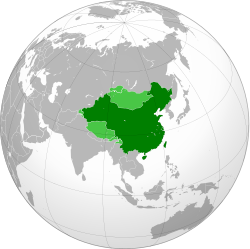Nationalist government (Republic of China)
The Nationalist government, officially the National Government of the Republic of China (Chinese: ; pinyin: Zhōnghuá Mínguó Guómín Zhèngfǔ; literally: "Chinese Republic National Government"), refers to the government of the Republic of China between 1 July 1925 to 20 May 1948, led by the Kuomintang (KMT, Chinese Nationalist Party). The name derives from the Kuomintang's translated name "Nationalist Party". The government was in place until the Government of the Republic of China under the newly promulgated Constitution of the Republic of China was established in its place.
After the outbreak of the Xinhai Revolution on 10 October 1911, revolutionary leader Sun Yat-sen was elected Provisional President and founded the Provisional Government of the Republic of China. To preserve national unity, Sun ceded the presidency to military strongman Yuan Shikai, who established the Beiyang government. After a failed attempt to install himself as Emperor of China, Yuan died in 1916, leaving a power vacuum which resulted in China being divided into several warlord fiefdoms and rival governments. They were nominally reunified in 1928 by the Nanjing-based government led by Generalissimo Chiang Kai-shek, which after the Northern Expedition, governed the country as a one-party state under the Kuomintang, and was subsequently given international recognition as the legitimate representative of China.
...
Wikipedia



